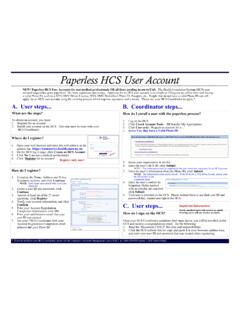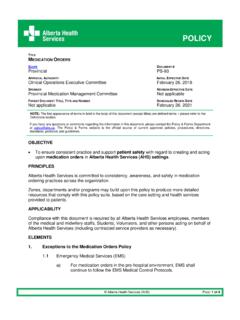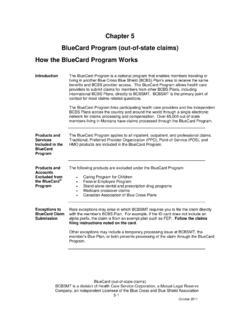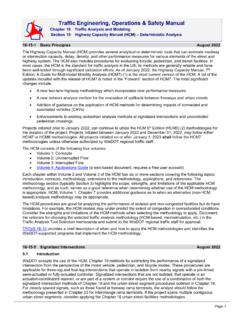Transcription of Safety Advisory: Risks of Improper Storage of Hazardous ...
1 EPA 550F21001 November 2021 Page 1 ---------------------------------------- ---------------------------------------- ---------------------------------------- ---------------------------------------- ---------------------------------------- ---------------------------------------- -------- Safety ADVISORY Risks of Improper Storage of Hazardous Chemicals at Chemical Warehouses and Chemical Distribution Facilities Safety concerns associated with Chemical Warehouse and Chemical Distribution Facilities If your facility manufactures, uses, or stores Hazardous chemicals, you may be required to comply with federal laws and regulations to ensure that these chemicals are managed safely and securely. In the past several years, federal agencies have visited numerous chemical warehouses and chemical distribution facilities ( , companies that process, formulate, blend, re-package, store, transport, and market chemical products) to determine compliance with applicable regulatory requirements for chemical accident prevention, preparedness, Safety , and security.
2 Based on information gathered, agencies found that many facilities do not manage chemicals in a safe or secure manner. Complying with applicable regulations may help avoid catastrophic chemical accidents.. Common concerns Failure to account for the chemicals in all containers (including aerosol cans, cylinders, Storage tanks, etc.) that could be impacted by the same emergency event, such as a fire. Failure to periodically inspect tank systems and ensure their integrity. Some chemical warehouse and distribution facilities may be failing to properly manage Hazardous chemicals as required by Section 112(r) of the Clean Air Act and the Emergency Planning and Community Right to Know Act (EPCRA) Sections 302, 304, 311, 312 and 313, enforced by the Environmental Protection Agency (EPA); the Process Safety Management (PSM) standard at 29 CFR , enforced by the Occupational Safety and Health Administration (OSHA); and the Chemical Facility Anti-Terrorism standards (CFATS) regulation at 6 CFR 27, and the Maritime Transportation Security Act regulation at 33 CFR 105, enforced by the Cybersecurity and Infrastructure Security Agency (CISA) and United States Coast Guard (USCG) respectively.
3 This advisory informs the industry that companies must ensure that their chemicals are managed safely, securely, and in compliance with EPA, OSHA, CISA and USCG programs to help prevent chemical accidents and security incidents. For example, ammonium nitrate, which is widely used in farming as fertilizer and stored in chemical warehouses, may be considered extremely Hazardous under certain circumstances. Failure to manage ammonium nitrate safely has caused some of the world s deadliest explosions, including most recently in Beirut, Lebanon, in 2020 and in West, Texas, in 2013. (West, Texas photo on left courtesy of Chemical Safety Board) Safety Advisory- Risks of Improper Storage of Hazardous Chemicals at Chemical Warehouses and Chemical Distribution Facilities Page 2 Failure to sufficiently coordinate with local emergency responders; local fire departments had Safety concerns about some facilities.
4 Storage of incompatible chemicals in close proximity to each other, creating a risk of fire, explosion, or release of toxic gases and fumes. Storage of flammable chemicals in buildings that are not structurally appropriate for such chemicals or that are not equipped with proper fire protection. Inadequate aisle space, hindering access by facility staff or emergency responders in the event of an accidental release. Inadequate secondary containment for chemicals to contain spills or leaks. Failure to file and implement an EPA Risk Management Program (RMP), often because insufficient inventory facility management systems failed to flag that chemical inventories had exceeded regulatory thresholds. Failure to include the entire weight of a flammable mixture with a National Fire Protection Association (NFPA) flammability rating of 4 in threshold calculations, not just the threshold amounts of individual EPA RMP regulated chemicals.
5 Failure to submit a Tier II form, Safety Data Sheet (SDS), or TRI Form R, in violation of EPCRA. Failure to complete a CISA CFATS Top-Screen, as well as not utilizing predictive filing to determine all reportable chemicals of interest. Regulatory Requirements for Chemical Warehouses and Chemical Distribution Facilities Applicable Requirements Environmental Protection Agency CAA Section 112(r)(7): Risk Management Program [40 CFR Part 68] Requires companies that have certain regulated chemicals over specified threshold quantities in a process (such as in Storage ) to develop a Risk Management Program which includes a(n): Chemical drums improperly stacked and some drums under duress. Chemical drums not properly labeled and no secondary containment. Insufficient aisle space between chemical drums. Safety Advisory- Risks of Improper Storage of Hazardous Chemicals at Chemical Warehouses and Chemical Distribution Facilities Page 3 Hazard assessment that details the potential effects of an accidental release, an accident history of the last five years, and an evaluation of worst-case and alternative accidental release scenarios; Prevention program that includes Safety precautions and maintenance, monitoring, and employee training measures; Emergency response program with requirements tied to whether or not the facility will rely on local emergency responders to respond to accidental releases; and Submission of a Risk Management Plan.
6 CAA Section 112(r)(1): General Duty Clause Requires owners and operators of facilities that have regulated chemicals and other extremely Hazardous substances to manage their chemicals safely. They must: Identify hazards which may result from accidental releases of such substances, using appropriate hazard assessment techniques (such as a What-if analysis); Design and maintain a safe facility, taking such steps as are necessary to prevent releases; and Minimize the consequences of accidental releases that do occur. EPCRA Section 302 [40 CFR Part 355] As required by Section 302, EPA has published a list of extremely Hazardous substances (EHSs) and their Threshold Planning Quantities (TPQs). Facilities are required to notify the State Emergency Response Commission (SERC) or Tribal Emergency Response Commission (TERC), and the Local Emergency Planning Committee (LEPC) or Tribal Emergency Planning Committee (TEPC) if any EHS is present at or above its TPQ within 60 days of first shipment or production of the substance on site.
7 State, tribal, and local agencies may have lower reporting thresholds for EHSs. EPCRA Section 304 and CERCLA Section 103 [40 CFR Part 355 and 302] EPCRA Section 304 requires facilities to immediately report accidental releases of certain chemicals to state, tribal and local authorities. Facilities must immediately report accidental releases of EHSs and Hazardous substances defined under the Comprehensive Environmental Response, Compensation, and Liability Act (CERLCA). Any releases of these substances that meet or exceed their corresponding Reportable Quantities (RQs) must be reported to the SERC/TERC and LEPC/TEPC. Facilities are also required to submit a written follow-up report within 30 days of these releases to these officials. Note many states and municipalities may have lower thresholds that trigger accidental reporting requirements and have shorter written follow-up reporting timeframes. CERCLA section 103 requires facilities to immediately report releases of CERCLA Hazardous substances that meet or exceed their corresponding RQs to the National Response Center (NRC).
8 EPCRA Sections 311 & 312: Safety Data Sheet (SDS) (formally Material Safety Data Sheet (MSDS)) Notification and Tier II Form [40 CFR Part 370] Requires facilities that have Hazardous chemicals ( , any material that requires an SDS) over specified reporting thresholds to: SDS Notification submit copies of SDSs or, alternatively, a list of Hazardous chemicals to the SERC/TERC and LEPC/TEPC and the local fire department. This is a one-time notification except for notifications when the SDS is updated with new information or if new Hazardous chemicals become present on site. Tier II Inventory Form submit an inventory of their Hazardous chemicals, including chemical name, quantity and location, annually by March 1st for the previous calendar year to the SERC/TERC, LEPC/TEPC, and local fire department. Additionally, rail yards that store Hazardous chemicals may also be subject to the EPCRA requirements. Hazardous chemicals present at rail yards are subject to EPCRA Sections 311 and 312 if they are not stored incident to transportation and they are present at the rail yard in amounts equal to or in excess of the minimum thresholds in 40 CFR (a).
9 See FAQs for additional information. Safety Advisory- Risks of Improper Storage of Hazardous Chemicals at Chemical Warehouses and Chemical Distribution Facilities Page 4 EPCRA Section 313: Toxic Release Inventory Reports (TRI) [40 CFR Part 372] Requires a facility to report annually on its pollution prevention and waste management activities, including releases, of certain chemicals, if the facility: Is in a TRI-covered industry sector (including chemical manufacturers and wholesalers) Employs 10 or more full-time employees; and Manufactures (including importing) or processes (including blending or repackaging) >25,000 pounds of a TRI-listed chemical or otherwise uses >10,000 pounds of a listed chemical in a given year, among other requirements. There are more stringent thresholds for chemicals of special concern ( , 10 pounds for mercury). Regulated facilities must submit TRI Forms to EPA and the applicable state or tribe by July 1st for the previous calendar year.
10 Department of Labor (OSHA) Process Safety Management (PSM): Standard [29 CFR ] OSHA s PSM standard sets requirements to address hazards associated with catastrophic releases of flammable, explosive, reactive, and toxic chemicals that may endanger workers. The PSM standard covers the manufacturing of explosives and processes involving threshold quantities of flammable liquids and flammable gases, as well as 137 other highly Hazardous chemicals. The PSM standard is similar but not identical to, EPA s RMP program. Explosives and Blasting Agents: Standard [29 CFR ] OSHA s standard sets requirements for manufacturing, keeping, having, storing, selling, transporting, and using explosives, blasting agents, and pyrotechnics. The standard also states that the manufacturing of explosives and pyrotechnics shall also meet the requirements of the PSM standard. The explosives and blasting agents standard specifically covers ammonium nitrate Storage in section (i), describing requirements for general Storage , bulk Storage , contaminants, electrical protection, and fire protection.


















